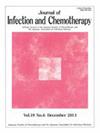临床背景和干预策略对结石性肾盂肾炎患者静脉注射抗生素疗程的影响:一项单中心回顾性研究。
IF 1.9
4区 医学
Q3 INFECTIOUS DISEASES
引用次数: 0
摘要
目的:在结石性肾盂肾炎中,需要进行适当治疗的信息有限,包括抗生素治疗的持续时间、尿液引流的时机和细菌的致病机理。在本研究中,我们调查了本院结石性肾盂肾炎病例的临床特征和成功治疗策略的真实数据,然后旨在建立预测模型,估算静脉注射抗生素治疗的持续时间:研究对象为2017年至2023年间在我院住院部接受抗生素治疗的163例结石性肾盂肾炎连续患者。可能影响抗生素治疗时间的解释变量包括年龄、性别、体重指数、结石位置、结石大小、化脓状态、血培养、尿液引流、留置尿道导管、糖尿病和类固醇摄入量:静脉注射抗生素的中位时间为 6 天(IQR:4-8 天)。74例(45.4%)患者接受了留置DJ支架或经皮肾造瘘术。多元回归分析显示,性别、年龄、留置尿道导管、脓毒症状态和尿液引流处理对静脉注射抗生素的基本疗程有独立影响,这些因素的回归系数估计值分别为 0.998、0.890、2.487、1.462、1.293,常数为 2.464:我们初步建立的预测静脉注射抗生素治疗时间的多元回归模型可能有助于判断那些在预计的静脉注射抗生素治疗时间内病情没有好转的患者改变治疗策略的时机。如果生命体征稳定,在静脉注射抗生素治疗后两天左右判断尿液从尿路结石上方排出是可以接受的。本文章由计算机程序翻译,如有差异,请以英文原文为准。
Impacts of clinical backgrounds and intervention strategies on duration of intravenous antibiotics treatments in patients diagnosed with calculous pyelonephritis: A single-center retrospective study
Objectives
There are limited information that need to do appropriate treatment including duration of antibiotic treatments, timing of urinary drainage and pathogenesis of bacteria in calculous pyelonephritis. In the present study, we investigated real-world data on clinical features and succeeded treatment strategies in calculous pyelonephritis cases in our hospital, then, aimed to make predictive model estimating duration of intravenous antibiotics treatment.
Methods
Participants were 163 consecutive patients diagnosed with calculous pyelonephritis who underwent antibiotics treatments between 2017 and 2023 in our in-patients’ clinic. Candidates for explanatory variables that may affect duration of antibiotic treatments were age, gender, body mass index, stone location, stone size, septic status, blood culture, urine drainage, indwelling urethral catheter, diabetes mellitus and steroid intake.
Results
Duration of intravenous antibiotics treatment was 6 days in median (IQR: 4–8 days). Indwelling DJ stent or percutaneous nephrostomy were undergone in 74 (45.4 %) patients. Multiple regression analysis revealed that gender, age, indwelling urethral catheter, septic status and management of urine drainage independently affected essential duration of intravenous antibiotics treatment and regression coefficient estimates of those factors respectively were 0.998, 0.890, 2.487, 1.462, 1.293 with constant of 2.464.
Conclusions
Our preliminary multiple regression models for predicting duration of intravenous antibiotics treatment may be useful to judge the timing of changing treatment strategies for patients who would not improve at around estimated intravenous antibiotics treatment periods. If vital signs were stable, it may be acceptable to judge urine drainage from above the urinary stone at around two days after intravenous antibiotic treatments.
求助全文
通过发布文献求助,成功后即可免费获取论文全文。
去求助
来源期刊

Journal of Infection and Chemotherapy
INFECTIOUS DISEASES-PHARMACOLOGY & PHARMACY
CiteScore
4.10
自引率
4.50%
发文量
303
审稿时长
47 days
期刊介绍:
The Journal of Infection and Chemotherapy (JIC) — official journal of the Japanese Society of Chemotherapy and The Japanese Association for Infectious Diseases — welcomes original papers, laboratory or clinical, as well as case reports, notes, committee reports, surveillance and guidelines from all parts of the world on all aspects of chemotherapy, covering the pathogenesis, diagnosis, treatment, and control of infection, including treatment with anticancer drugs. Experimental studies on animal models and pharmacokinetics, and reports on epidemiology and clinical trials are particularly welcome.
 求助内容:
求助内容: 应助结果提醒方式:
应助结果提醒方式:


